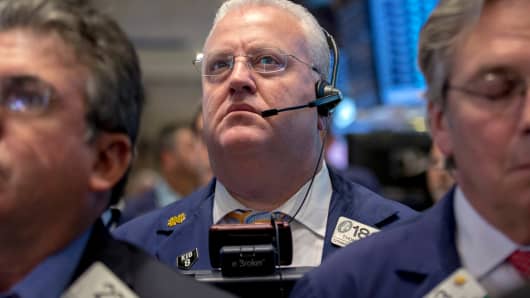Those who have stood on the sidelines based on an infinite list of concerns have paid a hefty price. Those who have held their noses and remained invested have profited handsomely.
Read MoreThanksgiving market outlook — just add bubbly!
So, putting aside fundamentals and the economy for now, there are basically three factors, all of which I consider technical or even psychological in nature, that have contributed greatly to the U.S. stock market strength.
The first factor, which you may have heard on CNBC or elsewhere, is "TINA", or "There is No Alternative" to stocks. Given the Fed's suppression of interest rates through aggressive monetary easing, investors have been pushed into riskier assets in the quest for acceptable returns. Many believe that the dearth of attractive investment alternatives to stocks has been the major impetus behind that surge in the stock market. Seems like a reasonable assertion.
The second factor is the belief that the U.S. is the best house in a bad neighborhood. To invest based on this premise, there must be an implicit assumption that the U.S. economy can still grow at an acceptable pace even though other economies remain in the doldrums. This belief (largely unproven) has been dubbed "decoupling."
The term decoupling was first en vogue early in the millennium when investors poured into emerging market stocks based on the belief that a sluggish U.S. economy would not affect economic growth in those regions. Well, we found out the hard way that the U.S. remains omnipotent within the global investment landscape.
Read MoreFive things to watch on Black Friday
Will investors learn the hard way that U.S. economic growth remains heavily dependent on the rest of the world?
And finally, and perhaps most importantly, is the "Fed put." A put is a financial derivative that allows an investor to sell an underlying security at a set price in the future. It is essentially an insurance policy against sharp losses in that underlying security. The "Fed put" refers to the notion that investors hold an insurance policy against major stock-market losses because the Federal Reserve has repeatedly stepped in to bail them out when storm clouds appeared.
The technical word for this type of behavior is "moral hazard." In my view, this has been the single-biggest factor in the meteoric rise in stock prices since the market lows in March 2009. If you think your loss potential is capped, you're naturally more inclined to invest.
Read MoreWe're 6 years into 20-year bull market: Belski
Each of these three factors, which admittedly have some overlap, have drawn money into U.S. stocks despite continued lackluster economic data. Moreover, stocks have continued to climb in the face of major geopolitical risks, threats of a government shutdown, an Ebola scare, and numerous other factors that might normally lead to a reduced appetite for stocks (or at least some profit-taking). As we look to the future, how much support can we expect from these non-fundamental factors?
It seems to me that the fundamentals will have to take the baton at some point, and here's why.
As interest rates rise in the U.S., a TINA-based investment approach will be less powerful. Bonds and other fixed income securities compete with stocks for investment dollars, and so higher interest rates will take demand away from stocks at some point. This transition can be gradual, or it can be abrupt. We're all hoping for the former.
With regard to "decoupling," I have never been a subscriber to this theory. The global economy is increasingly interconnected, and therefore economic weakness outside the U.S. will inevitably take a toll on U.S. growth at some point. At the very least, continuing strength in the U.S. dollar will translate to pressure on U.S. corporate profits and GDP growth. At worst, the U.S. will effectively import deflation from Japan, Europe and elsewhere.
Finally, the elimination of the Fed put is my biggest concern.
Central bankers worldwide have engaged in a very risky (and reckless) experiment, the outcome of which is highly uncertain. Ben Bernanke, Janet Yellen, et al have used monetary policy to drive up asset prices in a trickle-down maneuver that has had limited success. At each pullback in stock prices, the Fed has been there to reassure investors that it will continue to support prices. Now we have to somehow wean ourselves off this support.
The easy part is over. Let's all hope the pump has been primed, because if not there may be some volatility ahead.



